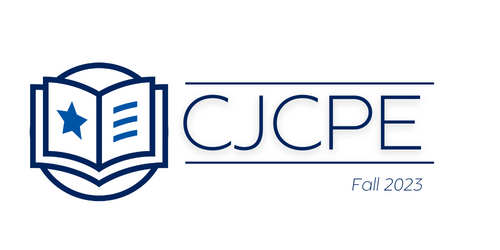Abstract
Student-led clinics offer opportunities for students to engage in interprofessional education (IPE); however, scheduling and transportation difficulties can affect their participation. Telehealth platforms may overcome some of these challenges. Students in health professional programs held monthly interprofessional consultation clinics (IPCC) for family medicine patients referred by their primary care providers. To improve accessibility, in-person visits were switched to telehealth encounters. Furthermore, to investigate the impact of the clinic on IPE competencies, students were invited to complete the Interprofessional Collaborative Competency Attainment Survey (ICCAS) questionnaire before and after the clinic sessions. Debriefs and semi-structured interviews with stakeholders were conducted at the clinics. Over the course of 1 year, 13 patients were seen at monthly clinics staffed by 156 individuals (i.e., students and providers from medicine, nursing, dietitian, occupational therapy, pharmacy, physical therapy, physician assistant, and social work programs). Paired student responses to the ICCAS demonstrated a significant change at the post-clinic time point compared to pre-visit responses. The clinics generated 124 recommendations for the reference providers. The providers were enthusiastic about the model and indicated the implementation of several student suggestions. The patients appreciated their attention, recommendations, and the ability to participate at home. Even when conducted using telehealth technologies, IPCCs appear to promote students’ attainment of interprofessional competencies and are favorably received by stakeholders.
References
World Health Organization. (2010). Framework for action on interprofessional education and collaborative practice. Geneva, Switzerland: WHO Press. Available from: https://apps.who.int/iris/bitstream/handle/10665/70185/WHO_HRH_HPN_10.3_eng.pdf?sequence=1&isAllowed=y
Drummond N, Abbott K, Williamson T, Somji B. Interprofessional primary care in academic family medicine clinics: implications for education and training. Can Fam Physician. 2012;58(8):e450-e458. Available from: https://www.ncbi.nlm.nih.gov/pmc/articles/PMC3419002/pdf/058e450.pdf
Shrader S, Thompson A, Gonsalves W. Assessing Student Attitudes as a Result of Participating in an Interprofessional Healthcare Elective Associated with a Student-Run Free Clinic. J Res Interprof Pract Educ. 2010;1(3):23. Available from: https://www.ncbi.nlm.nih.gov/pmc/articles/PMC3566658/pdf/nihms350503.pdf
Abraham HN, Opara IN, Dwaihy RL, et al. Engaging Third-Year Medical Students on Their Internal Medicine Clerkship in Telehealth During COVID-19. Cureus. 2020;12(6):e8791. Published 2020 Jun 24. doi:10.7759/cureus.8791
Castillo M, Conte B, Hinkes S, et al. Implementation of a medical student-run telemedicine program for medications for opioid use disorder during the COVID-19 pandemic. Harm Reduct J. 2020;17(1):88. Published 2020 Nov 17. doi:10.1186/s12954-020-00438-4
Neumann-Podczaska A, Seostianin M, Madejczyk K, et al. An Experimental Education Project for Consultations of Older Adults during the Pandemic and Healthcare Lockdown. Healthcare (Basel). 2021;9(4):425. Published 2021 Apr 6. doi:10.3390/healthcare9040425
Hean S, Craddock D, O’Halloran C. Learning theories and interprofessional education: A user’s guide. Learn Health Soc Care. Published 2009 Dec;8(4):250-262. doi.org/10.1111/j.1473-6861.2009.00227.x
Archibald D, Trumpower D, MacDonald CJ. Validation of the interprofessional collaborative competency attainment survey (ICCAS). J Interprof Care. 2014;28(6):553-558. doi:10.3109/13561820.2014.917407
Kruse CS, Krowski N, Rodriguez B, Tran L, Vela J, Brooks M. Telehealth and patient satisfaction: a systematic review and narrative analysis. BMJ Open. 2017;7(8):e016242. Published 2017 Aug 3. doi:10.1136/bmjopen-2017-016242
Patel P, Dhindsa D, Eapen DJ, et al. Optimizing the Potential for Telehealth in Cardiovascular Care (in the Era of COVID-19): Time Will Tell. Am J Med. 2021;134(8):945-951. doi:10.1016/j.amjmed.2021.03.007
Farlow JL, Goodwin C, Sevilla J. Interprofessional education through service-learning: lessons from a student-led free clinic. J Interprof Care. 2015;29(3):263-264. doi:10.3109/13561820.2014.936372
Lie DA, Forest CP, Walsh A, Banzali Y, Lohenry K. What and how do students learn in an interprofessional student-run clinic? An educational framework for team-based care. Med Educ Online. 2016;21:31900. Published 2016 Aug 5. doi:10.3402/meo.v21.31900
Hall S, Harrison CH, Stephens J, et al. The benefits of being a near-peer teacher. Clin Teach. 2018;15(5):403-407. doi:10.1111/tct.12784
George L, Bemenderfer S, Cappe M, Goncalves K, Hornstein M, Savage C, et al. A model for providing free patient care and integrating student learning and professional development in an interprofessional student-led clinic. J Phys Ther Edu. 2017;31(2):54-66. Available from: https://www.proquest.com/openview/676e746f6a50414a86d27616b387cb4e/1?pq-origsite=gscholar&cbl=26719

